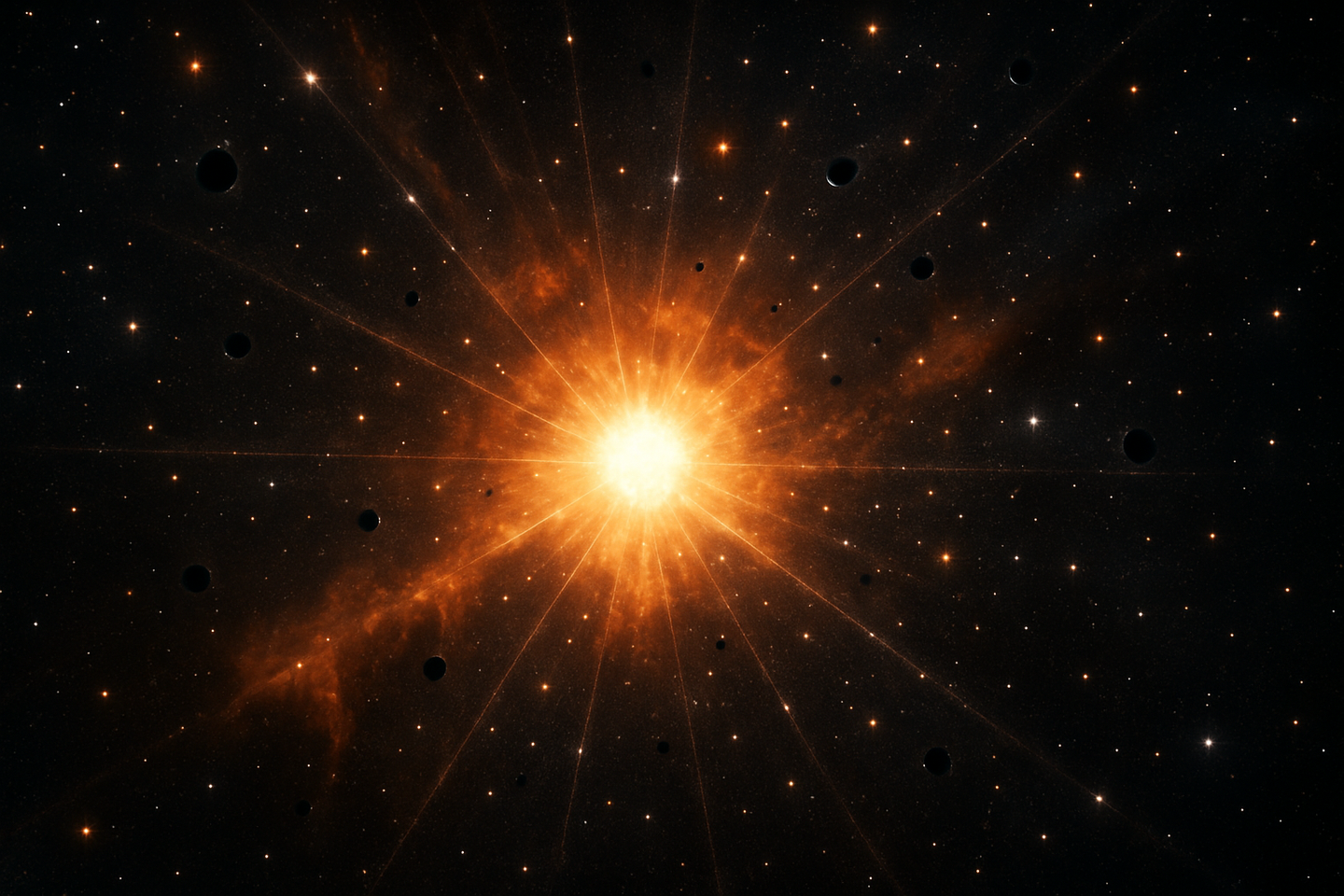Astronomers reveal what happened less than a second after the Big Bang
A new study proposes that tiny particle halos collapsed and formed primordial black holes and exotic stars moments after the Big Bang.

 Edited By: Joshua Shavit
Edited By: Joshua Shavit

Early matter era may have formed the first black holes and exotic stars before nucleosynthesis. (CREDIT: AI-generated image / The Brighter Side of News)
Cosmologists have traced the Big Bang’s earliest moments with great care, from the explosive inflation that set spacetime in motion to the period of newborn atomic nuclei known as primordial nucleosynthesis. Yet a long stretch between those events remains mysterious.
A new study published in Physical Review D suggests that this forgotten chapter may have been far more active than once believed. If a temporary early matter dominated era took hold in those first fractions of a second, tiny clumps of particles may have collapsed under their own weight and created the first black holes and exotic stars long before galaxies existed.
A hidden era after inflation
Researchers from Scuola Internazionale Superiore di Studi Avanzati (SISSA) along with colleagues at INFN, IFPU, and the University of Warsaw explored a scenario in which dense particle clouds briefly overpowered radiation in the newborn cosmos. That shift would have allowed small ripples in density to grow into halos of matter.
These halos, though tiny compared with galaxies today, carried enough mass to behave like self-gravitating systems. Their internal energy worked in unusual ways. When such systems lose energy, their cores heat up and contract. That rise in temperature then speeds up further energy loss. This runaway effect encourages the core to shrink.
In normal stars and galaxies, radiation releases that trapped heat. In this early era, however, the particles did not produce light. The team found that strong interactions among the particles themselves could play the role that radiation usually fills. Those interactions let hotter particles escape and carry energy away, which encourages even faster contraction.
How collapsing halos make compact objects
The team studied a simple particle model that allowed them to track how halos behaved from their birth to their collapse. Once a halo formed, it remained mostly collisionless at first. Over time, particle interactions grew stronger as the core became denser. Hotter particles left the center, taking energy with them. The core then contracted and grew even hotter. When the particles reached about one third the speed of light, the core crossed into an unstable state.
That instability could push the system toward several possible outcomes. One path leads to primordial black holes, tiny but incredibly dense objects that formed long before stars and galaxies. Another path creates short-lived structures known as cannibal stars. These stars burn not through fusion but through particle self-annihilation. A third possible outcome produces boson stars. These objects form when quantum pressure from the wave nature of particles supports the core against gravity.
All three structures would have existed only briefly. Cannibal and boson stars may have survived for only seconds before collapsing even further.
A range of black hole sizes
The researchers found that halos formed during this early matter era could hold masses up to about ten to the twenty eighth grams. When those halos collapsed, only a small part of that mass fell into a black hole. Most black holes produced by this process would therefore be extremely small, ranging from about ten to the fourteenth to ten to the twentieth grams.
Even though these primordial black holes would be tiny by astrophysical standards, their creation could have shaped the later Universe. Some may have survived until today. Others may have evaporated through Hawking radiation long ago.
In some cases, the process produces too many black holes, which would conflict with what astronomers observe. In others, the halos make asteroid scale black holes that could supply some or even all of the dark matter. Under yet another set of conditions, so many black holes evaporate before nucleosynthesis that they briefly act as the dominant form of matter before disappearing.
A new window into cosmic history
This view of primordial black hole formation does not rely on large ripples seeded by inflation. Instead, it works with ordinary fluctuations and well motivated particle physics. That makes the proposed mechanism a promising complement to older theories. It also highlights three physical knobs that shape the outcome: the temperature at which radiation takes over again, the length of the matter dominated era, and the particle interaction strength.
The researchers say this approach could offer a new way to probe hidden sectors and unknown particle interactions. It may also inspire studies of similar collapse processes in today’s Universe. Self interacting dark matter halos could in theory form cannibal or boson stars even now, although that possibility remains speculative.
Practical Implications of the Research
This work opens a new path for exploring the dark side of the early Universe. If these tiny halos formed compact objects soon after the Big Bang, they may have left fingerprints in today’s cosmic signals. Primordial black holes could make up some part of dark matter or rule out certain particle models by their absence.
Short lived black holes that evaporated early would have injected energy into the young cosmos and may have altered nucleosynthesis or the early growth of structure. Cannibal and boson stars, if they formed, could help scientists understand how new forces or particle interactions behaved at extreme densities.
Together, these ideas give researchers new tools to study physics that regular experiments cannot reach and may deepen our understanding of how the Universe grew from its earliest states.
Research findings are available online in the journal Physical Review D.
Related Stories
- What came before the Big Bang? Supercomputers take on Einstein's equations
- Strange 'Cosmic Grapes' galaxy sheds new light on first billion years after Big Bang
- Harvard and Cambridge scientists disprove the Big Bang's inflation theory
Like these kind of feel good stories? Get The Brighter Side of News' newsletter.
Joseph Shavit
Science News Writer, Editor-At-Large and Publisher
Joseph Shavit, based in Los Angeles, is a seasoned science journalist, editor and co-founder of The Brighter Side of News, where he transforms complex discoveries into clear, engaging stories for general readers. With experience at major media groups like Times Mirror and Tribune, he writes with both authority and curiosity. His work spans astronomy, physics, quantum mechanics, climate change, artificial intelligence, health, and medicine. Known for linking breakthroughs to real-world markets, he highlights how research transitions into products and industries that shape daily life.



